AMD Zen 3 Ryzen Deep Dive Review: 5950X, 5900X, 5800X and 5600X Tested
by Dr. Ian Cutress on November 5, 2020 9:01 AM ESTSection by Andrei Frumusanu
The New Zen 3 Core: Front-End Updates
Moving on, let’s see what makes the Zen3 microarchitecture tick and how detail on how it actually improves things compared to its predecessor design, starting off with the front-end of the core which includes branch prediction, decode, the OP-cache path and instruction cache, and the dispatch stage.
From a high-level overview, Zen3’s front-end looks the same as on Zen2, at least from a block-diagram perspective. The fundamental building blocks are the same, starting off with the branch-predictor unit which AMD calls state-of-the-art. This feeds into a 32KB instruction cache which forwards instructions into a 4-wide decode block. We’re still maintaining a two-way flow into the OP-queue, as when we see instructions again which have been previously decoded, they are then stored in the OP-cache from which they can be retrieved with a greater bandwidth (8 Mops/cycle) and with less power consumption.
Improvements of the Zen3 cores in the actual blocks here include a faster branch predictor which is able to predict more branches per cycle. AMD wouldn’t exactly detail what this means but we suspect that this could allude to now two branch predictions per cycle instead of just one. This is still a TAGE based design as had been introduced in Zen2, and AMD does say that it has been able to improve the accuracy of the predictor.
Amongst the branch unit structure changes, we’ve seen a rebalancing of the BTBs, with the L1 BTB now doubling in size from 512 to 1024 entries. The L2 BTB has seen a slight reduction from 7K to 6.5K entries, but allowed the structure to be more efficient. The indirect target array (ITA) has also seen a more substantial increase from 1024 to 1536 entries.
If there is a misprediction, the new design reduces the cycle latency required to get a new stream going. AMD wouldn’t exactly detail the exact absolute misprediction cycles or how faster it is in this generation, but it would be a more significant performance boost to the overall design if the misprediction penalty is indeed reduced this generation.
AMD claims no bubbles on most predictions due to the increased branch predictor bandwidth, here I can see parallels to what Arm had introduced with the Cortex-A77, where a similar doubled-up branch predictor bandwidth would be able to run ahead of subsequent pipelines stages and thus fill bubble gaps ahead of them hitting the execution stages and potentially stalling the core.
On the side of the instruction cache, we didn’t see a change in the size of the structure as it’s still a 32KB 8-way block, however AMD has improved its utilisation. Prefetchers are now said to be more efficient and aggressive in actually pulling data out of the L2 ahead of them being used in the L1. We don’t know exactly what kind of pattern AMD alludes to having improved here, but if the L1I behaves the same as the L1D, then adjacent cache lines would then be pulled into the L1I here as well. The part of having a better utilisation wasn’t clear in terms of details and AMD wasn’t willing to divulge more, but we suspect a new cache line replacement policy to be a key aspect of this new improvement.
Being an x86 core, one of the difficulties of the ISA is the fact that instructions are of a variable length with encoding varying from 1 byte to 15 bytes. This has been legacy side-effect of the continuous extensions to the instruction set over the decades, and as modern CPU microarchitectures become wider in their execution throughput, it had become an issue for architects to design efficient wide decoders. For Zen3, AMD opted to remain with a 4-wide design, as going wider would have meant additional pipeline cycles which would have reduced the performance of the whole design.
Bypassing the decode stage through a structure such as the Op-cache is nowadays the preferred method to solve this issue, with the first-generation Zen microarchitecture being the first AMD design to implement such a block. However, such a design also brings problems, such as one set of instructions residing in the instruction cache, and its target residing in the OP-cache, again whose target might again be found in the instruction cache. AMD found this to be a quite large inefficiency in Zen2, and thus evolved the design to better handle instruction flows from both the I-cache and the OP-cache and to deliver them into the µOP-queue. AMD’s researchers seem to have published a more in-depth paper addressing the improvements.
On the dispatch side, Zen3 remains a 6-wide machine, emitting up to 6-Macro-Ops per cycle to the execution units, meaning that the maximum IPC of the core remains at 6. The Op-cache being able to deliver 8 Macro-Ops into the µOp-queue would serve as a mechanism to further reduce pipeline bubbles in the front-end – as the full 8-wide width of that structure wouldn’t be hit at all times.
On the execution engine side of things, we’ve seen a larger overhaul of the design as the Zen3 core has seen a widening of both the integer and floating-point issue width, with larger execution windows and lower latency execution units.
Starting off in more detail on the integer side, the one larger change in the design has been a move from individual schedulers for each of the execution units to a more consolidated design of four schedulers issuing into two execution units each. These new 24-entry schedulers should be more power efficient than having separate smaller schedulers, and the entry capacity also grows slightly from 92 to 96.
The physical register file has seen a slight increase from 180 entries to 192 entries, allowing for a slight increase in the integer OOO-window, with the actual reorder-buffer of the core growing from 224 instructions to 256 instructions, which in the context of competing microarchitectures such as Intel’s 352 ROB in Sunny Cove or Apple giant ROB still seems relatively small.
The overall integer execution unit issue width has grown from 7 to 10. The breakdown here is that while the core still has 4 ALUs, we’ve now seen one of the branch ports separate into its own dedicated unit, whilst the other unit still shares the same port as one of the ALUs, allowing for the unshared ALU to dedicate itself more to actual arithmetic instructions. Not depicted here is an additional store unit, as well as a third load unit, which is what brings us to 10 issue units in total on the integer side.
On the floating-point side, the dispatch width has been increased from 4 µOps to 6 µOps. Similar to the integer pipelines, AMD has opted to disaggregate some of the pipelines capabilities, such as moving the floating point store and floating-point-to-integer conversion units into their own dedicated ports and units, so that the main execution pipelines are able to see higher utilisation with actual compute instructions.
One of the bigger improvements in the instruction latencies has been the shaving off of a cycle from 5 to 4 for fused multiply accumulate operations (FMAC). The scheduler on the FP side has also seen an increase in order to handle more in-flight instructions as loads on the integer side are fetching the required operands, although AMD here doesn’t disclose the exact increases.



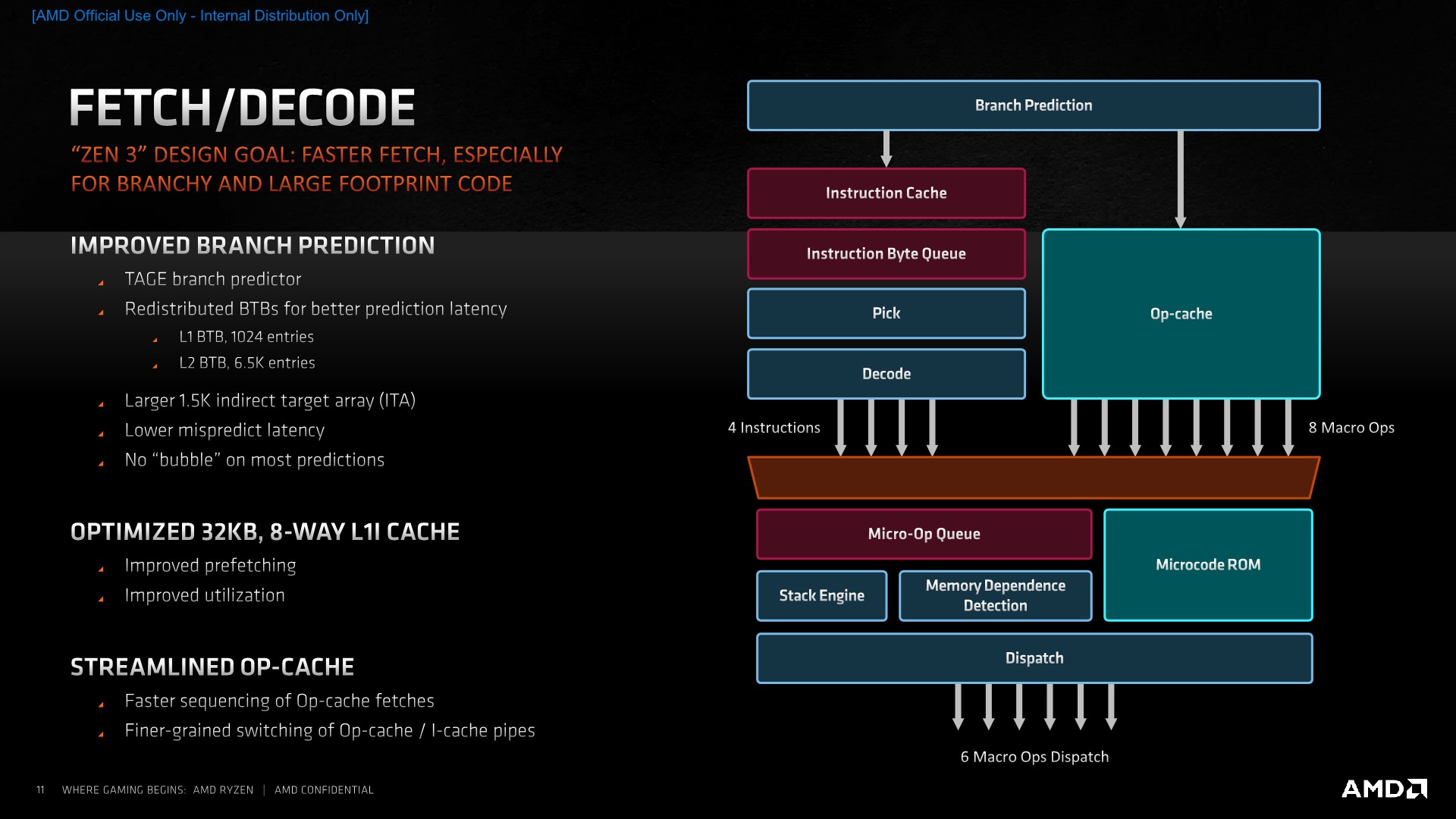
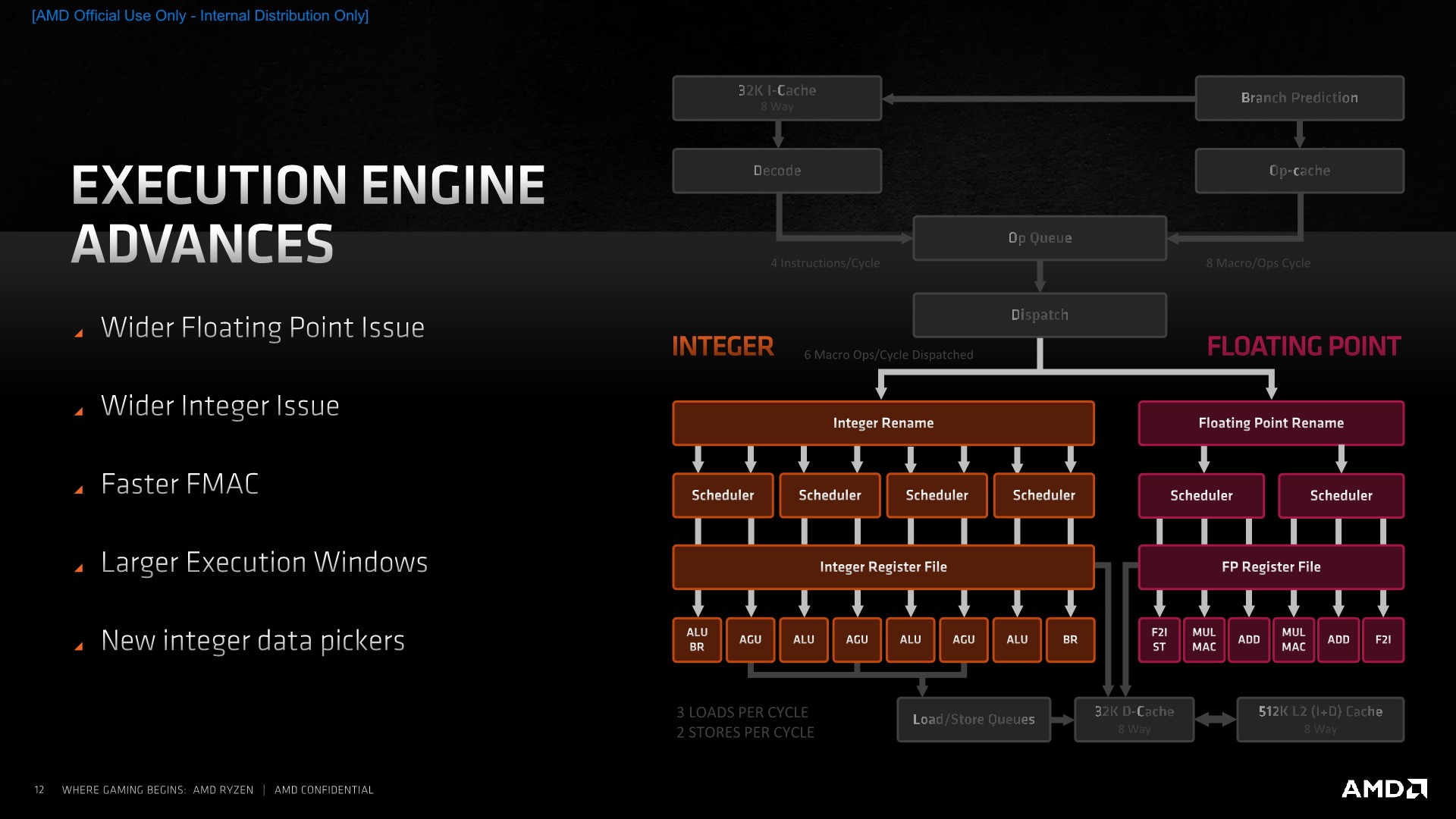
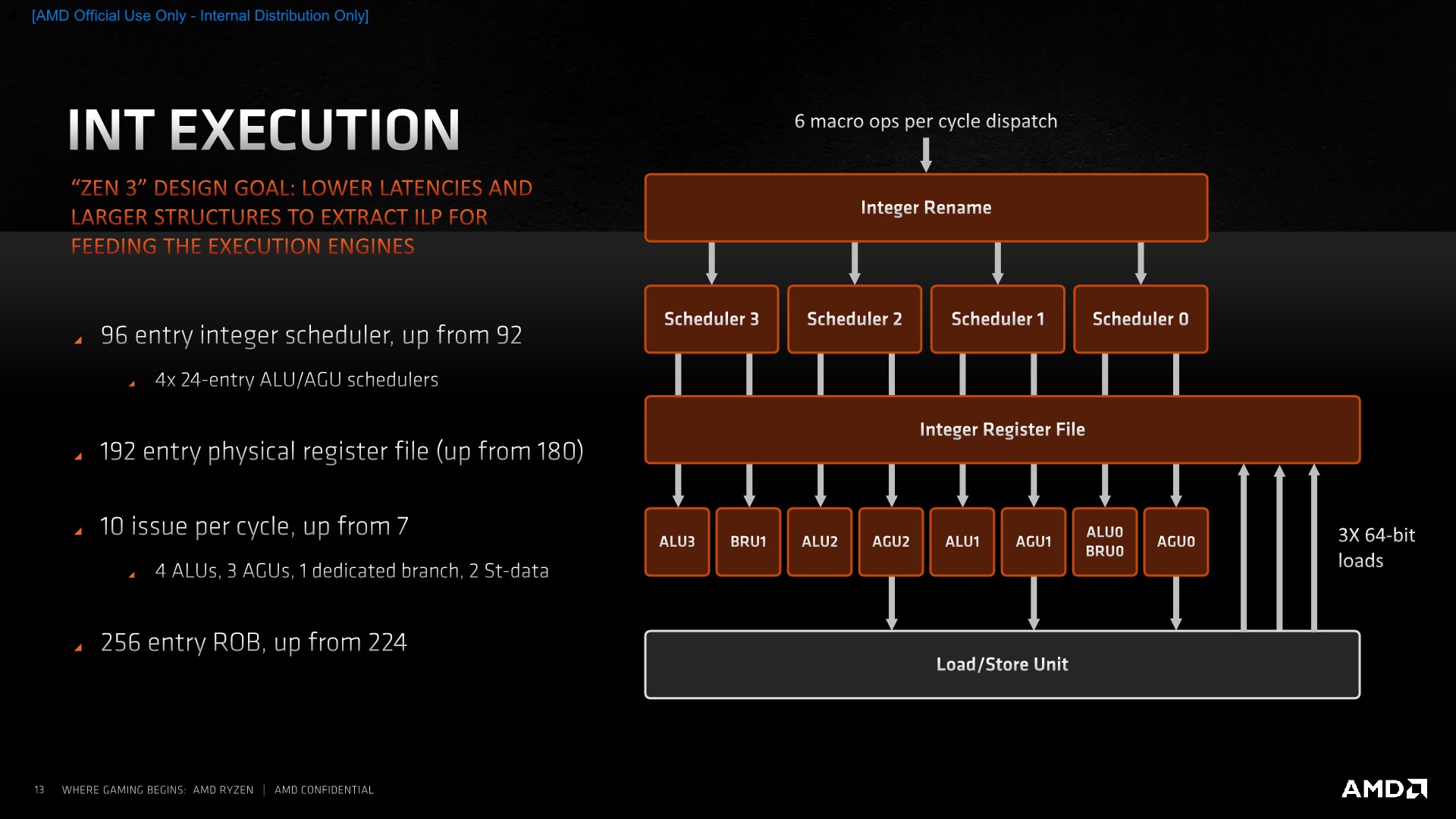
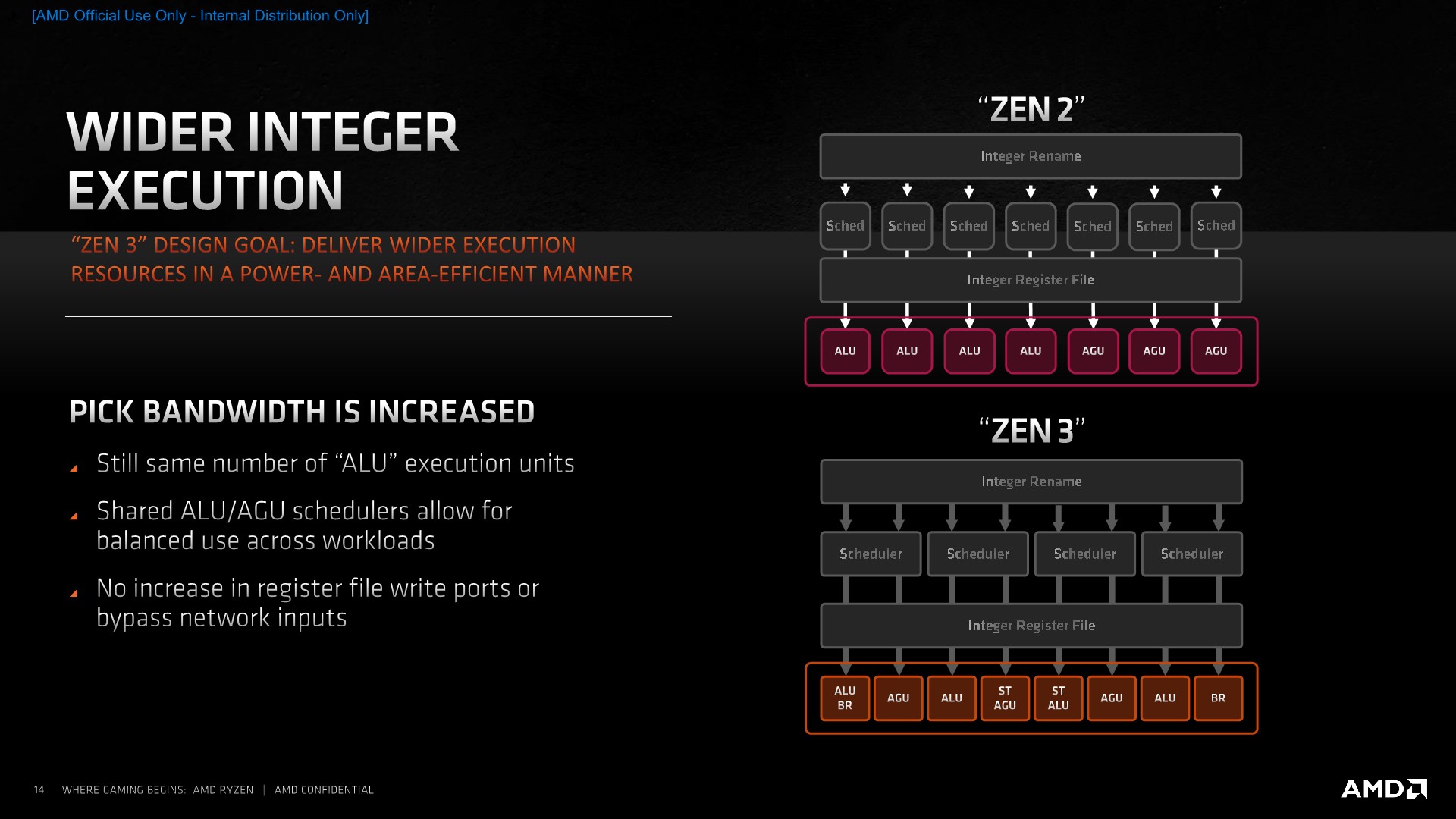
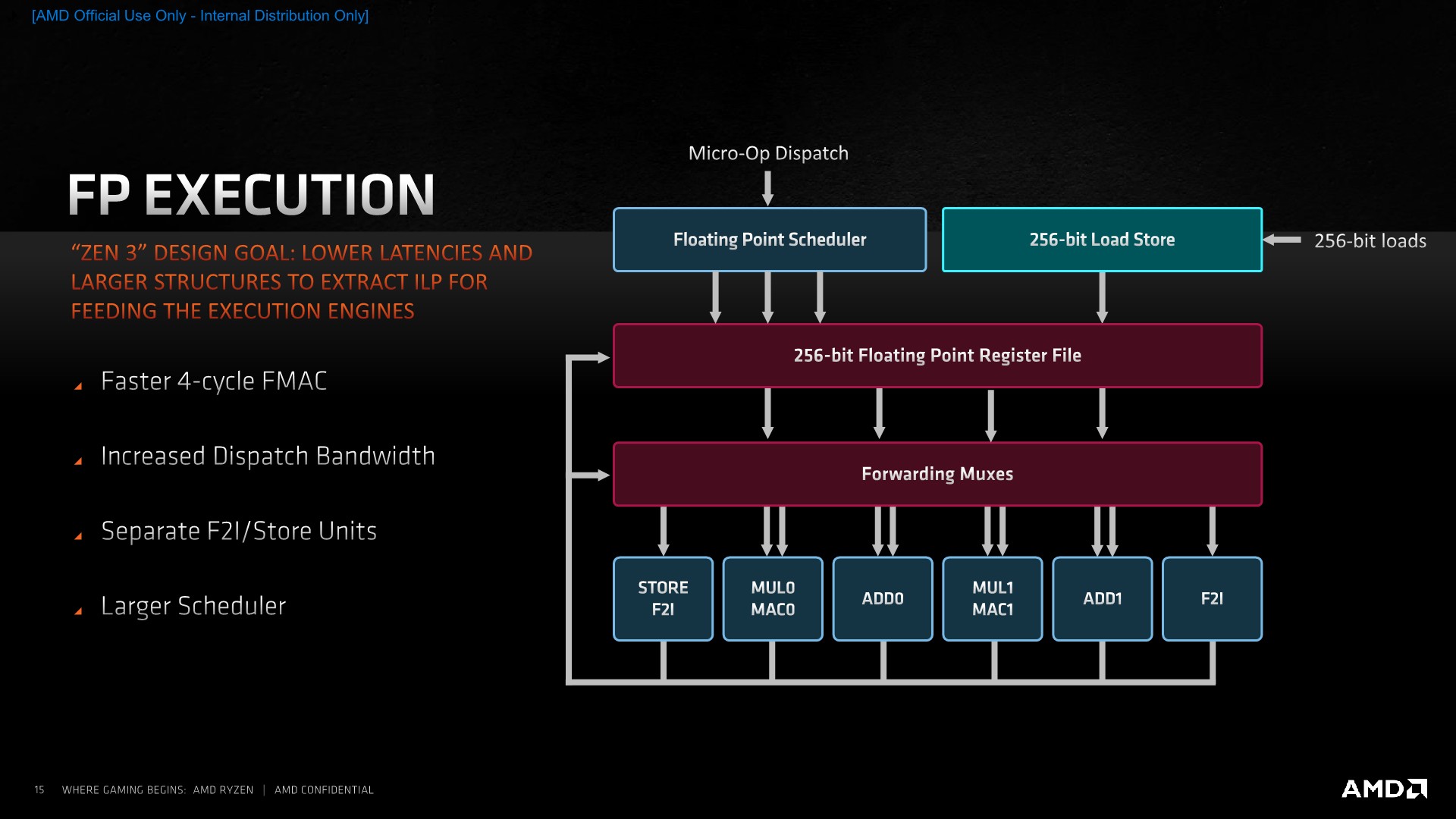








339 Comments
View All Comments
TheinsanegamerN - Tuesday, November 10, 2020 - link
There is no x590 chipset coming. X570 is ryzen 5000s chipset.There's also this miracle fo technology, if you have a micro atx or full atx board, you can put in ADD IN CARDS. Amazing, right? So even if your board does not natively support 2.5G LAN you can add it for a low price, because 2.5G cards are relatively cheap.
TheinsanegamerN - Tuesday, November 10, 2020 - link
the x570 aorus master and msi x570 unify also have 2.5G lan. And surely there will be newer models next year with newer features and names, gotta keep the model churn going!alhopper - Sunday, November 8, 2020 - link
Ian and Andrei - 1,000 Thank Yous for this awesome article and you fine technical journalism. You guys did amazing work and we (the community) are fortunate to be the benefactors.Thanks again and keep up the Good Work (TM).
Rekaputra - Sunday, November 8, 2020 - link
Wow this article it so comprehensive. Glad i always check anandtech for my reference in computing. I wonder how it stack againt threadripper on database or excel compute workload. I know these are desktop proc. But there is possibility use it for mini workstation for office stuff like accounting and development RDBMS as it is cheaper.SkyBill40 - Sunday, November 8, 2020 - link
Once some availability comes back into play... my old and trusty FX 8350 is going to be retired. I've been waiting to rebuild for a long time now and the wait has clearly paid off regardless of how the is the end of the line for AM4 or well Ryzen 4 does next year. I could wait... but nah.jcromano - Friday, November 13, 2020 - link
I'm in a similar boat. I'm still running an i5-2500k from early 2011 (coming up on ten years, yikes), and I'll build a new rig, probably 5600X, when the processors become available. I fret a bit over whether I should wait for the next socket to arrive before taking the plunge, but given the infrequency with which I upgrade, I think it's likely that the next socket would also be obsolete by the time it mattered.evilpaul666 - Sunday, November 8, 2020 - link
I'd love to see some PS3 emulation testing added.abufrejoval - Monday, November 9, 2020 - link
Control flow integrity (or enforcement) seem to be in, and that was for me a major criterion for getting one (5800X scheduled to arrive tomorrow).But what about SEV or per-VM-encryption? From the hints I see this seems enabled in Intel's Tiger Lake and I guess the hardware would be there on all Zen 3 chiplets, but is AMD going to enable it for "consumer" platforms?
With 8 or more cores around, there is plenty of reasons why people would want to run a couple of VMs on pretty much anything, from a notebook to a home entertainment/control system, even a gaming rig. And some of those VMs we'd rather have secure from phishing and trojans, right?
Keeping this an EPIC-only or Pro-only feature would be a real mistake IMHO.
BTW ordered ECC DDR4-3200 to go with it, because this box will run 24x7 and pushes a Xeon E3-1276 v3 into cold backup.
lmcd - Monday, November 9, 2020 - link
Starting to feel like the platform is way too constrained just for the sake of all 6 APUs AMD has released (all with mediocre graphics and most with mediocre CPUs, no less). I hope AMD bifuricates and comes up with an in-between platform that supports ~32-40 CPU PCIe lanes and drops APUs. If APUs can't be on-time with everything else there's so little point.29a - Monday, November 9, 2020 - link
"Firstly, because we need an AI benchmark, and a bad one is still better than not having one at all."Can't say I agree with that.